

6.) the Russian empire. Russian Empire. Former empire in Eurasia (1721–1917) and North America (1721–1867) The Russian Empire[b] was a historical empire that extended across Eurasia and North America from 1721, following the end of the Great Northern War, until the Republic was proclaimed by the Provisional Government that took power after the February Revolution of 1917.[4][5] The third-largest empire in history, at its greatest extent stretching over three continents, Europe, Asia, and North America, the Russian Empire was surpassed in size only by the British and Mongol empires, leaving the empire lasting 196 years.
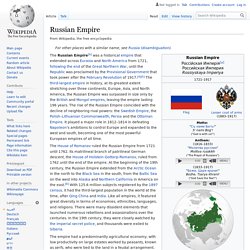
The rise of the Russian Empire coincided with the decline of neighboring rival powers: the Swedish Empire, the Polish–Lithuanian Commonwealth, Persia and the Ottoman Empire. It played a major role in 1812–1814 in defeating Napoleon's ambitions to control Europe and expanded to the west and south, becoming one of the most powerful European empires of all time. History[edit] Population[edit] Foreign relations[edit] 7.) Revolution and the Russian republic. Russian Provisional Government. Coordinates:
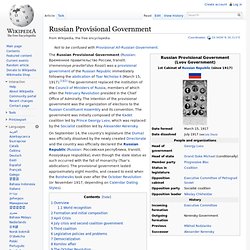
Russian Republic. The Russian Republic (Russian: Россiйская республика, tr.
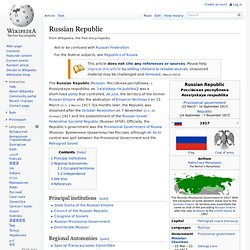
Rossiyskaya respublika, IPA: [rɐˈsʲijskəjə rʲɪsˈpublʲɪkə]) was a short-lived polity that controlled, de jure, the territory of the former Russian Empire after the abdication of Emperor Nicholas II on 15 March [O.S. 2 March] 1917. February Revolution. The February Revolution (Russian: Февра́льская револю́ция, IPA: [fʲɪvˈralʲskəjə rʲɪvɐˈlʲʉtsɨjə]) of 1917 was the first of two revolutions in Russia in 1917.
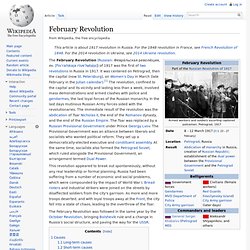
It was centered on Petrograd, then the capital (now St. 8.) Soviet Russia and civil war. October Revolution. The October Revolution (Russian: Октя́брьская револю́ция, tr.
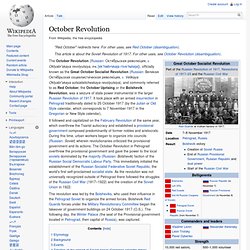
Oktyabr'skaya revolyutsiya, IPA: [ɐkˈtʲæbrʲskəjə rʲɪvɐˈlʲʉtsɨjə]), officially known as the Great October Socialist Revolution (Russian: Вели́кая Октя́брьская социалисти́ческая револю́ция, tr. Velikaya Oktyabr'skaya sotsialisticheskaya revolyutsiya), and commonly referred to as Red October, the October Uprising or the Bolshevik Revolution, was a seizure of state power instrumental in the larger Russian Revolution of 1917.
It took place with an armed insurrection in Petrograd traditionally dated to 25 October 1917 (by the Julian or Old Style calendar, which corresponds to 7 November 1917 in the Gregorian or New Style calendar). Etymology[edit] Initially, the event was referred as the October coup (Октябрьский переворот) or the Uprising of 25th, as seen in contemporary documents (for example, in the first editions of Lenin's complete works). Background[edit] A scene from the July Days. Russian Soviet Federative Socialist Republic. The Russian Soviet Federative Socialist Republic (Russian: Российская Советская Федеративная Социалистическая Республика[5], tr.

Rossiyskaya Sovetskaya Federativnaya Sotsialisticheskaya Respublika), commonly referred to as Soviet Russia, the Russian Federation, or simply Russia,[2][6] was a sovereign state (in 1917–22 and 1990–91) and the largest, most populous, and most economically developed republic of the Soviet Union.[7] The Republic comprised sixteen autonomous republics, five autonomous oblasts, ten autonomous okrugs, six krais, and forty oblasts.[7] Russians formed the largest ethnic group. The RSFSR was established on November 7, 1917 (October Revolution) as a sovereign state.
Russian Constitution of 1918. Russian Civil War. The Russian Civil War (Russian: Гражданская война́ в Росси́и Grazhdanskaya voyna v Rossiy) (November 1917 – October 1922)[1] was a multi-party war in the former Russian Empire fought between the Bolshevik Red Army and the White Army, the loosely allied anti-Bolshevik forces.
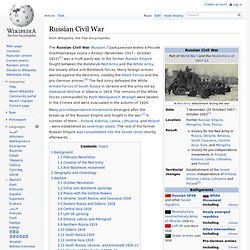
Many foreign armies warred against the Red Army, notably the Allied Forces and the pro-German armies.[4] The Red Army defeated the White Armed Forces of South Russia in Ukraine and the army led by Aleksandr Kolchak in Siberia in 1919. The remains of the White forces commanded by Pyotr Nikolayevich Wrangel were beaten in the Crimea and were evacuated in the autumn of 1920. Background[edit] February Revolution[edit] 9.) the Soviet union. Soviet Union. The Union of Soviet Socialist Republics (Russian: Сою́з Сове́тских Социалисти́ческих Респу́блик, tr.

Soyuz Sovetskikh Sotsialisticheskikh Respublik) abbreviated to USSR (Russian: СССР, tr. SSSR) or the Soviet Union (Russian: Сове́тский Сою́з, tr. Sovetskij Soyuz), was a socialist state on the Eurasian continent that existed between 1922 and 1991, governed as a single-party state by the Communist Party with Moscow as its capital.[3] A union of multiple subnational Soviet republics, its government and economy were highly centralized. A de-Stalinization period followed Stalin's death, reducing the harshest aspects of society.
The Soviet Union then went on to initiate significant technological achievements of the 20th century, including launching the first ever satellite and world's first human spaceflight, which led it into the Space Race. Geography, climate and environment History Revolution and foundation Unification of republics. Treaty on the Creation of the USSR. The Treaty along with the Declaration of the Creation of the USSR was approved on December 29, 1922 by a conference of delegations from the Russian SFSR, the Transcaucasian SFSR, the Ukrainian SSR and the Byelorussian SSR.

The Treaty and the Declaration were confirmed by the 1st Congress of Soviets of the USSR and signed by heads of delegations[1] – Mikhail Kalinin, Mikhail Tskhakaya, Mikhail Frunze and Grigory Petrovsky, Aleksandr Chervyakov[2] respectively on December 30, 1922. The treaty provided flexibility to admit new members. Therefore, by 1940 the Soviet Union grew from the founding four republics to 16 republics of the Soviet Union. History of the Soviet Union. 10.) the Russian Federation. History of Russia (1992–present) The history of Russia from 1992 to the present began with the dissolution of the Soviet Union on 26 December 1991, and the establishment of the Russian Federation.
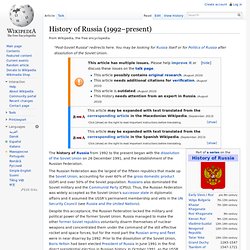
The Russian Federation was the largest of the fifteen republics that made up the Soviet Union, accounting for over 60% of the gross domestic product (GDP) and over 50% of the Soviet population. Russians also dominated the Soviet military and the Communist Party (CPSU). Thus, the Russian Federation was widely accepted as the Soviet Union's successor state in diplomatic affairs and it assumed the USSR's permanent membership and veto in the UN Security Council (see Russia and the United Nations). Russian economy since fall of the Soviet Union The conversion of the world's largest state-controlled economy into a market-oriented economy would have been extraordinarily difficult regardless of the policies chosen. The former Soviet Union was to deal with a number of unique obstacles during the post-Soviet transition. 1.) etymology. 2.) Early periods in Russian history.
East Slavs. European territory inhabited by East Slavic tribes in 8th and 9th century. The East Slavs are Slavic peoples speaking East Slavic languages. Formerly the main population of the medieval state of Kievan Rus, by the seventeenth century they evolved into the Russian, Ukrainian, and Belarusian[1] peoples. History[edit] Sources[edit] Goths. The Goths (Gothic: *Gut-þiuda,[1] *Gutans[2]; Old Norse: Gutar/Gotar; German: Goten; Latin: Gothi; Greek: Γότθοι, Gótthoi) were an East Germanic people, two of whose branches, the Visigoths and the Ostrogoths, played an important role in the fall of the Roman Empire and the emergence of Medieval Europe. An important source of knowledge of the Goths is Getica, a semi-fictional account, written in the 6th century by the Roman historian Jordanes, of their migration from southern Scandza (Scandinavia), into Gothiscandza—believed to be the lower Vistula region in modern Pomerania—and from there to the coast of the Black Sea.
Archaeological evidence from the Pomeranian Wielbark culture and the Chernyakhov culture, northeast of the lower Danube, confirms that some such migration did in fact take place. Gothic language and culture largely disappeared during the Middle Ages, although its influence continued to be felt in small ways in some western European states. Etymology[edit] Scythia. Scythia (Ancient Greek: Σκυθική; Modern Greek: Σκυθία Skythía, in English pronounced /siθiə/ or /siðiə/) – was a multinational region of Central Eurasia in the classical era, encompassing parts of Pontic steppe, Central Asia, Eastern Europe[citation needed]. Ancient Greeks gave the name Scythia (or Great Scythia) to all the lands north-east of Europe and the northern coast of the Black Sea, unknown to them in that era.
Little Scythia is the name of a modern Eastern European region. Later, Great Scythia became the name of the regions known today as Central Asia and the western part of Inner Asia[citation needed]. The Scythians – the Greeks' name for this nomadic people – inhabited Scythia from at least the 11th century BCE to the 2nd century CE.[1] Its location and extent varied over time but usually extended farther to the west than is indicated on the map opposite.[2] Geography[edit] The region known to classical authors as Scythia included: First Scythian kingdom[edit] Scythian kings[edit] Khazars. Bosporan Kingdom. Eurasian nomads. The Eurasian nomads were a large group of nomadic peoples of the Eurasian Steppe who often appear in history as invaders of Europe, The Middle East, and China.
This generic title encompasses the ethnic groups inhabiting the steppes of Central Asia, Mongolia, and what is now Russia. They domesticated the horse, and their economy and culture emphasizes horse breeding, horse riding, and a pastoral economy in general. 3.) the Kievan Rus period in Russian history. Kievan Rus' Kievan Rus' (Old East Slavic Рѹ́сь, Рѹ́сьскаѧ землѧ,[citation needed] Greek Ῥωσία, Latin Rus(s)ia, Ruscia, Ruzzia, Rut(h)enia,[1][2] Old Norse Garðaríki) was a loose federation[3] of East Slavic tribes in Europe from the late 9th to the mid-13th century,[4] under the reign of the Rurik dynasty. Rus' Khaganate. List of early East Slavic states. 4.) the Grand Duchy of Moscow. Grand Duchy of Moscow. The Grand Duchy of Moscow expanded through conquest and annexation from just 20,000 square kilometers in 1300 to 430,000 in 1462, 2.8 million in 1533, and 5.4 million by 1584.[1] It is taken to originate with Daniel I who inherited the town in 1283, eclipsing and eventually absorbing its parent duchy of Vladimir-Suzdal by the 1320s.
5.) the Tsardom of Russia. Tsardom of Russia.